#united states colonial marines
Photo





This time it’s war.
Artist: Jose Angel Trancón Fernández
Twitter: @AngelTrancon
#alien#aliens#aliens 1986#alien 3#uss sulaco#united states colonial marines#united states colonial marine corps#uscm#hadley's hope#xenomorph#hr giger#art
194 notes
·
View notes
Text


"AVEC LES ALLIES," La Presse. January 9, 1943. Page 2 & 3.
----
En haut, sous-marin français arrivant en rade d'Alger après avoir réussi à quitter Toulon peu avant le sabotage de la flotte française. Les marins seluent joyeusement. En bas, traces des dégâts causé par un raid nazi à Alger après l'occupation de la ville par les Américains.
EN AFRIQUE DU NORD
Le port de Safi au Maroc a repris vie depuis l'occupation de l'Afrique du Nord par les Américains. Le grand vaisseau que l'on voit au centre est un porteur de tanks. Photographie aérienne prise au début de l'occupation.
Soldats américains manoeuvrant une mitrailleuse anti-tank de 37 millimètres dans un avant-poste près de l'aéroport de Safi, au Maroc. Bien que l'occupation se soit faite presque sans combat les Américains se préparent de pied ferme à combattre toute attaque des Nazis ou des Italiens.
#world war ii#operation torch#north african campaign#french north africa#forces navales françaises libres#toulon#algiers#safi#morocco#algeria#french colonial empire#united states army#anti-tank gun#aerial bombardment#submariners#sous-marin#flotte française
0 notes
Text
Japanese construction workers on Wednesday resumed landfill work at the new site of the U.S. military base on Okinawa despite protests by the island’s residents that the move tramples on their rights and raises environmental concerns.
The planned relocation site for the base, on Okinawa’s eastern coast, has been at the center of a dispute between the government in Tokyo and the local authorities at a time of the island’s growing strategic importance.[...]
Three weeks ago, the Fukuoka High Court’s Naha branch ordered Okinawa Gov. Denny Tamaki to approve the central government’s modified landfill plan, and allowed the Land and Transport Ministry to order the work to resume by overriding the governor’s disapproval.
On a barge brought to the location on Wednesday, a pair of loader machines scooped up mounds of rock and gravel and dumped them into the sea as part of reclamation needed to reinforce the extremely soft seabed at the site planned for U.S. Marine Corps Air Station Futenma.
Tamaki, who has appealed the order to the Supreme Court, said the court ruling was unjust and goes against the will of the residents. Under Japanese law, construction can proceed while the court decision is pending. He called the resumption of the landfill work “extremely regrettable.”[...]
Tamaki, the governor, has sought a significant reduction of the U.S. military on Okinawa, which is home to more than half of 50,000 American troops based in Japan under a bilateral security pact.
Hundreds of scholars, film directors and ordinary citizens who have advocated for Okinawans’ autonomy, signed a global petition demanding the island cease to be “a de facto military colony of the United States and Japan ever since the end of the World War II.”
One of the petition organizers, Satoko Norimatsu Oka who heads the Vancouver-based Peace Philosophy Center, provided a copy of the document to The Associated Press.
“We must end the discrimination and military colonization of Okinawa,” said the petitioners, who include filmmaker Oliver Stone.
The petition urged President Joe Biden and Japanese Prime Minister Fumio Kishida to “cancel the construction of the new base in Henoko.”
10 Jan 24
121 notes
·
View notes
Text
What is unique, at least since the era of open colonialism and its genocides, is the unity this carnage has inspired among political elites in the Global North, and to some extent beyond it. After all, when fascism rose in Europe the 1930s, it had powerful supporters in our political classes, but it also had powerful opponents.
That is far less true today. All across what passes for a political spectrum, from the rabid far right to the mealy-mouthed centre left, we have witnessed powerful actors putting their partisan differences aside to come together in active support of these crimes against humanity. Far from fracturing our political class, this iteration of fascism has united it: Donald Trump agrees with Joe Biden; Rishi Sunak with Keir Starmer, Emanuel Macron with Marine Le Pen; Justin Trudeau with Giorgia Meloni; Viktor Orbán with Narendra Modi.
And so, we must ask: On what precisely do they all agree? What are they uniting behind? What are they all defending when they speak of Israel’s ‘right to defend itself’?
It’s too simple, I’m afraid, to say they are united in defense of a single state. They are, of course, but they are also united in defense of a shared belief system. Amidst the reality of global economic apartheid and accelerating climate breakdown, they are united in a shared supremacist vision of safety and security for the few. This vision is the flip side of their steadfast refusal to in any way address the underlying drivers of these crises: capitalism, limitless growth, colonialism, militarism, white supremacy, patriarchy.
As Sherene Seikaly puts it, we are ‘In the age of catastrophe’ and ‘Palestine is a paradigm’.
75 notes
·
View notes
Photo
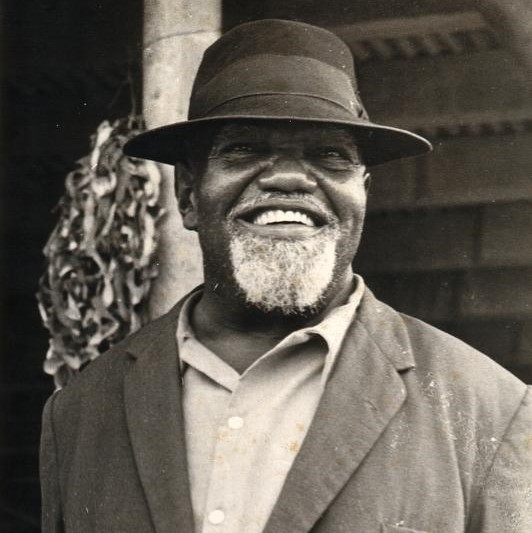
On this day, 19 June 1933, the National Unemployed Movement held a hunger march in Port of Spain, the capital of Trinidad. Hundreds of demonstrators demanded relief work for the unemployed and the restoration of rent controls which had been scrapped by British colonial authorities. On the same date three years later, 19 June 1937, after employers failed to agree to oil workers' pay demands, workers at one of Trinidad's oilfields went on strike. British colonial authorities attempted to arrest Uriah Butler, a former oil worker-turned preacher, who was helping to lead the dispute. However, he was defended by a crowd of workers, who killed two policemen – soaking one of them with paraffin and burning them. Butler (pictured) then went into hiding. The strike quickly spread across all oilfields, then to the rest of the economy. A state of emergency was declared and two British warships rushed to the island, arriving on 22 and 23 June, bringing marines and additional police from England and Ireland. Two local military units were also mobilised against the workers, and after numerous arrests and imprisonments the rebellion was quashed. Butler was captured in September and jailed for 2 years for sedition. Learn more about these struggles in Trinidad and Tobago in our latest podcast - out in the next few days for our patreon supporters at https://www.patreon.com/workingclasshistory https://www.facebook.com/photo.php?fbid=646981504141735&set=a.602588028581083&type=3
146 notes
·
View notes
Text
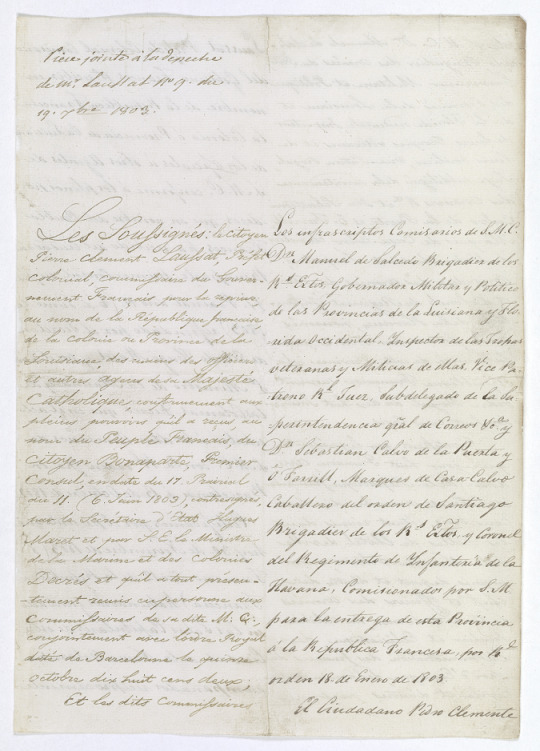
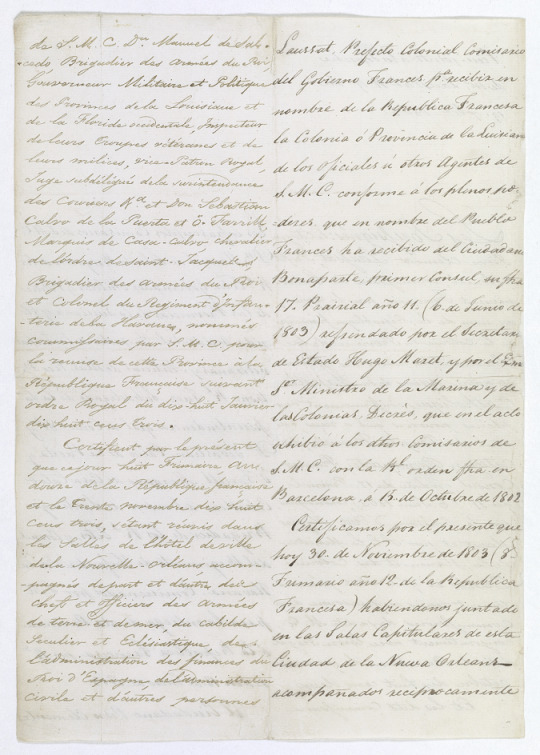

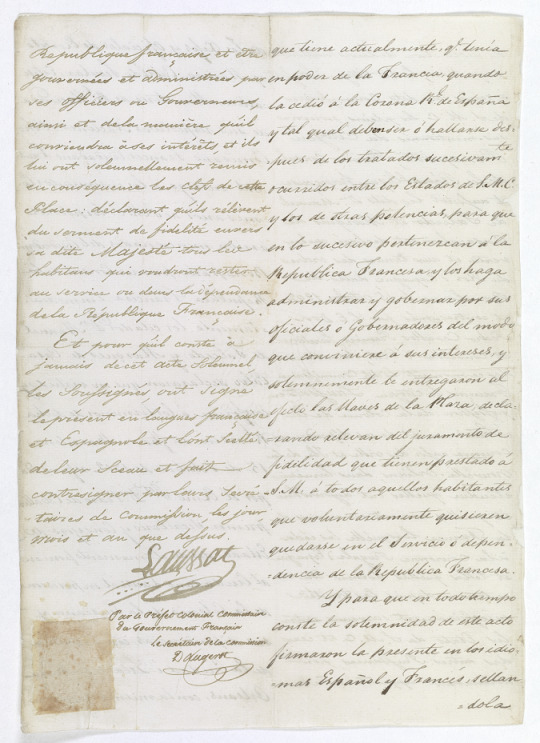
Original Protocol of the Delivery of Louisiana by Spain to France, at New Orleans on November 30, 1803
Record Group 11: General Records of the United States GovernmentSeries: Perfected TreatiesFile Unit: TS 86 AO: Treaty for the cession of Louisiana - English and French texts
[Handwritten] Pièces jointes à la depeche de Mr. Laussat n[']o 9. du 19. 7bre 1803. [Main body of document follows; French-language text on the left; Spanish-language text on the right (this pattern continues throughout the body of the document).] [French text follows -- first:] Les Soussignés : le citoyen Pierre Clement Laussat, Préfet colonial, commissaire du Gouvernement Français pour la reprise, au nom de la République Française, de la colonie ou Province dela Louisiane, des mains des officiers et autres agens desa Majesté Catholique, conformement aux pleins pouvoirs qu'il a reçus, au nom du Peuple Francais, du Citoyen Bonaparte, Premier Consul, en date du 17. Prairial an 11. (6. Juin 1803), contresignés, par le Secrétaire d'Etat Hugues Maret et pour S. E. le Ministre de la Marine et des Colonies Decrés et qu'il a tout présentement remis enpersonne aux Commissaires de sa dite M. C., conjointement avec l'ordre Royal daté de Barcelonne le quinze Octobre dix huit cens deux; Et les dits Commissaires [Spanish-language text follows (on right on original sheet/image):] Los infrascriptos Comisarios de S.M.C. D[']n. Manuel de Salcedo Brigadier de los R[']s Extos,.Gobernador Militar y Politico de las Provincias de la Luisiana y Florida Occidental, Ynspector de la Tropas veteranas y Milicias de ellas, Vice Patrono R[']l Juez, Subdelegado de la Superintendencia g[']ral [with tilde over the "r"] de Correos y c.[']a [?] y D[']n. Sebastian Calvo de la Puerta y O Farrill, Marques de Casa-Calvo Caballero del orden de Santiago Brigadier de los R[']s Ex[']tos, [with tilde over the "t"] y Coronel del Regimento de Ynfantería de la Havana, Comisionados por S.M. para la entrega de esta Provincia á la Republica Francesa, por R[']l. orden 18.. de Enero de 1803. El Ciudadano Pedro Clemente [full transcription at link]
35 notes
·
View notes
Text
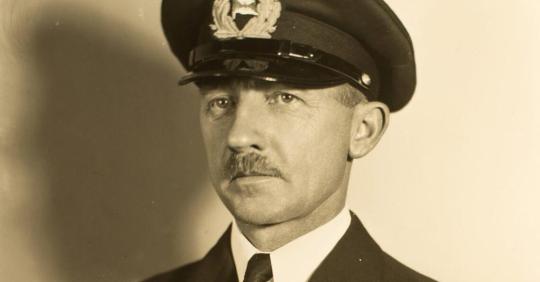
Courageous Captain
Voyage of the Damned
Gustav Schroder was a German sea captain who sailed to Cuba in 1939 with 937 Jewish refugees and went to extraordinary lengths to save their lives after multiple countries — including the U.S. – refused to grant them asylum.
Born in Hadersleben, Denmark (then part of the German Empire) in 1885, Gustav was always drawn to the ocean. He first went to sea at age 16, aboard a training ship, and then became an able seaman on one of the fastest ships in the world, part of the Hamburg America Line fleet. He served with distinction in the merchant marine for 24 years and was then appointed captain.
Always eager to travel to new places, Gustav was excited when his first posting as Captain was to India, then a British colony. He arrived in Calcutta in 1913, but unfortunately the outbreak of World War in 1914 upended all his plans. As a German, Gustav was classified as an enemy alien and kept in an internment camp. With nothing to do, he began learning languages, and by the time the war ended in 1918 he was spoke seven. Gustav returned to Germany in 1919 and found it difficult to get a job in a defeated Germany where production of ships was greatly reduced. Finally in 1921, Gustav found employment once again with the Hamburg America Line, where he served on various ships for 15 years.
As anti-semitism rose in Germany during the 1930’s, Gustav became increasingly troubled. A man with respect for all peoples and curiosity about different cultures, Gustav was horrified by the vicious persecution targeting Jews. In 1938, the pogrom known as Kristallnacht occurred, when Jews were attacked and murdered in the streets by a rampaging horde consisting of soldiers and civilians. Many Jews died that day, and hundreds of business and synagogues burned to the ground. Gustav knew he had to do something, and he got his chance when he was appointed captain of the MS St. Louis, a diesel-powered passenger ship that sailed the trans-Atlantic route from Hamburg to Canada and New York.
In 1939, Gustav set sail for Cuba on the St. Louis with a ship full of passengers. Unlike the usual carefree vacationers, the passengers on this voyage were 937 Jewish refugees seeking asylum. The Jews all had legal tourist visas to Cuba, so it was assumed there wouldn’t be an issue accepting the refugees when they arrived. During the voyage, Gustav insisted the passengers be treated with great respect, and provided with all of the comforts enjoyed by other cruising passengers. There were concerts, dances, swimming, and even religious services. A bust of Hitler was covered with a tablecloth. Those aboard the ship were deeply grateful for their miraculous rescue, and called the trip “a vacation cruise to freedom.”
However, when the ship arrived at Havana Harbor the captain and passengers of the St. Louis were in for a terrible surprise. The Cuban authorities had recently changed their immigration policy, and the Jews’ tourist visas were rejected. Only 28 passengers – American, Spanish or Cuban nationals – were considered to have “valid” documents, and they were allowed to disembark. The ship sat in the harbor for a week while American officials tried to persuade Cuba to accept all of the refugees, but to no avail. Cuba absolutely refused to take any more passengers.
Because the Americans had advocated for helping the stateless Jews, Gustav sailed from Cuba to the coast of Florida. He sought permission to enter the United States, but the U.S. government steadfastly refused to help. admit even one Jew. Even Cuba accepted 28, but President Franklin Roosevelt wouldn’t accept a single Jew. This remained his position throughout the next several years, as the Jews of Europe were systematically slaughtered. Roosevelt could have done so much, and chose to do nothing at all. (Shockingly, many Jews then and now consider him a hero.)
Gustav was appalled at the American government’s actions, and he made a bold plan to actually run the ship aground and allow the refugees to escape. However, Roosevelt’s Secretary of State Cordell Hull instructed the Coast Guard to shadow the St. Louis and make sure Gustav couldn’t carry out his plan. The “vacation cruise to freedom” became the “voyage of the damned.”
The next hope was Canada, but the Immigration Director insisted that his country, like their neighbor to the north, tightly shut their doors to admit no Jews. Gustav desperately negotiated with several governments while conditions on the ship became dire, without enough food and supplies for an extended voyage. He absolutely refused to return the ship to Germany until the refugees had found homes.
Finally on June 17 1939, the St. Louis docked at the Port of Antwerp. Britain, France, Belgium and the Netherlands agreed to accept the Jewish refugees, evenly distributed to all four countries. Sadly, the following year Nazi Germany occupied Belgium, France and the Netherlands. Most of the Jews who had been returned to those countries were ultimately deported to concentration camps. Based on extensive research, historians estimate that 254 of the passengers who returned to Europe were killed in the Holocaust. Thankfully approximately 709 of the Jewish refugees who sailed on the St. Louis survived the war, and they all (and their thousands of descendants) owe their lives to Gustav Schroder.
After the St. Louis arrived back in Hamburg, Gustav was reassigned to a desk job and never went to sea again. Ironically, he was investigated as a possible war criminal during post-war de-Nazification proceedings, but many of the Jews he saved testified on his behalf and he was released. As Germany slowly came to a reckoning of the nation’s role in the genocide of European Jews, heroes began receiving official recognition. In 1957 Gustav was awarded the Order of Merit by the Federal German Republic “for services to the people and the land in the rescue of refugees.” Two years later, Gustav died in Hamburg at age 73. He was survived by his wife and children.
Posthumously, Gustav was honored as Righteous Among the Nations by Israeli Holocaust Memorial Yad Vashem. A street in Hamburg is named after him. In 1976, a movie was made about the St. Louis. Voyage of the Damned starred Max von Sydow as Gustav, and featured an all-star cast including Faye Dunaway, Lee Grant, James Mason and Malcolm McDowell.
For his extraordinary actions of bravery that saved 709 lives, we honor Gustav Schroder as this week’s Thursday Hero.
54 notes
·
View notes
Note
learned a new whaling fact and immediately thought of telling you: whaling is still legal in some parts of japan, but the reasoning is that its traditional to some first nations of japan and the government doesnt wanna be like ‘hey guys whose land we stole and colonized…. uhhh stop your traditions too’
It is a whaling fact that I don’t believe is…exactly correct. People who have their thumb on the pulse of contemporary commercial & subsistence whaling more than I can jump in on this, too.
Currently the International Whaling Commission permits indigenous subsistence whaling as it connects to cultural importance and food sovereignty in four regions: Greenland, Chukotka, Bequia, and Alaska. Canada, to my knowledge isn’t part of the IWC, but also allocates specific quotas to subsistence whaling among indigenous groups in the Canadian Arctic. The Makah people in Washington state are also currently advocating for the ability to resume subsistence whaling too and it looks like that’ll come about soon (here’s a really good recent article on it). In my neck of the woods, when a dead whale washes up on a beach often due to vessel strikes, there have been members of the Shinnecock nation who perform a centuries-old ceremony called ‘podtap’ to honor the whale. But access to the whale beyond that is still restricted. Courtney Leonard, a Shinnecock artist spoke to this in an artist’s statement:
“Can a culture sustain itself when it no longer has access to the environment that fashions that culture?
Due to nation agreements with the United States government as well as New York State, topics of sovereignty, imposed law and environmental issues impacting our nation, The Shinnecock Nation of what is now referred to as Long Island, NY, has and continues to struggle with access to the material of the whales as they wash ashore having been often struck by the shipping boats that pass our waters.
Through the work of BREACH and by having the opportunity to travel to and connect with other indigenous water communities throughout the world, I have been able to research and learn about our common struggles and unique narratives as they pertain to 'access' and 'understanding'. "
In Alaska, the Inupiat hunt bowhead whales (again, within a quota) and also have a relationship with marine biologists tracking the bowhead population. Through that relationship biologists were able to receive an anatomical sample of one of the whales from the annual hunt (an eyeball), and by studying that sample to better understand the whales’ lifespan we now know that there are individual bowheads today who were alive during the height of the 19th century industry.
For the Inuit, they still aren’t able to hunt whales because the eastern bowhead (unlike the western), haven’t had as strong a population recovery/don’t have as much research to draw from. That same partnership with scientists is happening in the hopes that more information can be known about the population so the Inuit can ultimately resume their hunting rights. There’s a neat documentary about this here.
By law, indigenous people are still required to hunt whales the laborious ‘traditional’ way, rather than adopting new technologies that exist in the contemporary commercial whale fishery. And international environmental law is often slow to respond to what is best for those indigenous communities.
Japan (as well as Norway and Iceland) is largely involved in the commercial fishery today. But I think it’s important to note in relation to this ask that Japan was never colonized by Western imperial forces. Japan itself is a colonial power. And while there were small shore whaling fishing communities in Japan that existed prior to the ‘modern’ industry, it wasn’t until the latter half of the 19th century that Japan saw whaling as an expansion of that empire (modeled off the American imperial expansion that was also happening through whaling). There’s a good essay about this in the book Across Species and Cultures called Birth of A Pelagic Empire written by Jakobina Arch.
In our current day, Japan for a time used loopholes in the IWC that permitted killing whales for ‘scientific research’, and it pulled out of the Commission in 2019. Only a few hundred people are employed by the whaling industry in Japan today, and Norway (which also objected to the IWC quotas) still kills the most whales out of the three countries, but currently isn’t meeting its own internal quotas. Iceland states it’ll be pulling out of the industry by 2024. There are also international restrictions on what whale species are hunted, linking back to the population devastation that started in the 19th century and became even more ruinous in the 20th century as technology grew. Contemporary commercial whaling is a water I don’t particularly like to wade into, but ultimately it seems that regardless of what arguments are happening around it, commercial consumption of whale meat is on the decline in all of these places and thus it makes sense that commercial whaling will soon follow suit.
35 notes
·
View notes
Text
AU Lore Spotlight: The Horus Rebellion
I've made vague and indirect reference to this event, so I figure as I try to get back into the swing of writing this world, I should do a mini lore-dive into my headcanons surrounding the infamous Horus Rebellion.
First, the canon and canon-adjacent information: The event was first (and only once) teased in canon in Metroid Prime 3: Corruption. A GF Marine trooper posits idly in conversation that the Phazon Crisis might be worse than "the Horus Rebellion," which was the last time Admiral Dane had scrambled such an impressive number of fighter vessels. In unused scans, we have the name of a significant battle, "The Battle of Horus IV," but little other information. Notably this cut lore entry also mentions Aurora Unit 313's contribution to this battle (whether alongside or in place of Admiral Dane is unclear), and its penchant for violent behaviour. I think it's interesting that point was cut out, the foreknowledge that 313 had a bit of a mean streak could have added some nice context to its role near the end of Corruption. But I digress.
Now, my take. As mentioned in the first wikitroid article linked above, the "Horus Rebellion" is almost certainly a reference to the Warhammer 40,000 "Horus Heresy", a major event in the 40k canon. Now despite living with some Warhammer nerds and having watched a couple lore videos about the Horus Heresy, I could not tell you the first thing about it. So my take on this event will not be influenced by the obvious reference material. Sorry WH fans, it's just not my thang.
Instead, my version of this is more influenced by my Eclipse Phase experience, as is a lot of Electrochromic's AU lore. In EP, since it's a gritty-ish Cyberpunk setting, corporations rule the world(s) in various capacities. Corpos wield a huge amount of power and control a lot of settlements, including spaceborne habitats. This is the jumping-off point for my version of the Horus Rebellion.
In "Iron and Sulfur" I use the phrase "sovereign-corporate habitat" to describe Kypros. This is exactly what it sounds like; a habitat owned and operated by a corporation, considered a sovereign micro-state unto itself. These habs may be subject to the planetary law of the corporation's homeworld, but generally they exist outside any such government organizations (usually for slightly unscrupulous business reasons) and run under their own internal corporate system of law. Kind of like a "company town" on steroids, and in space. Before the Horus Rebellion, the Galactic Federation was relatively hands-off with regard to sovereign-corporate habs, trusting the local or planetary governments to maintain peace and equity.
Horus Star Corporation was a materials processing and weapons manufacturing corp that had claimed a corner of Federated space for itself. Horus SC was allowed to operate freely, as its business was a boon to the rapidly-developing Federation military at the time. When a newly-formed Federation colony began encroaching on territory that Horus SC claimed was theirs, the corporation went on the offensive and outright attacked the fledgling Federation colony. This of course meant the GF Marine Corps had to intervene.
Being a weapons manufacturing business, the Horus private troops were startlingly well-armed, and the attack on the GF colony was a massacre. However, the GFMC had the advantage of numbers, and the counterattack against the Horus forces was also a slaughter. The amount of military might leveled against Horus was staggering for a conflict of such relatively small scale. By necessity, as the corporate force was well-equipped and tenacious. But the cultural memory of the "Horus Rebellion" remains a dark and bloody one that echoes into the present of the AU's timeline.
This was the root of Samus's concern over accidentally drawing the Federation to Kypros. Since the Horus Rebellion, the Galactic Federation has taken a much tougher stance on sovereign-corporate habs, outlawing them altogether in territories close to Daiban and other centers of power. Company-funded habitats are required to have an (often strict) oversight board or supervisor that reports to the nearest branch of GF government, and all station security equipment is heavily regulated, if security is not provided directly by a GF military base nearby or on-site. Since Kypros is outside Federated space, they are not subject to such harsh scrutiny or regulation. But it would be easy for a sufficiently motivated officer to justify an attempt to "subdue" or shut down such a station if it proved an obstacle to military operations in the area.
Hence why Samus was so afraid of Fuja appearing at Kypros. She wasn't just afraid for her own or Adam's safety, but for the safety of the station as a whole; her old friend Ghor, and Helena and the Twins who she had newly come to know, along with the innocent mining staff who would have no idea why their station was suddenly under attack. Thankfully, as clarified in a previous ask, despite her temper, Fuja knew better than to engage here. Among other confounding factors, another instance of a Federation fleet stomping a corporate hab into paste would not look good. Although Admiral Dane remains a well-respected officer despite his participation, neither side of the Rebellion is remembered kindly by history, so many people - officers, freelancers, and corpos alike - err on the side of caution when faced with the potential for such conflicts.
#electrochromic#metroid#metroid series#electrochromic lore#sable's fic#iron and sulfur#warhammer 40k#eclipse phase
11 notes
·
View notes
Photo



Armored vehicles illustrated for the Aliens: Colonial Marines Technical Manual book. Illustrated by Lee Brimmicombe-Wood.
#alien#aliens#colonial marines#united states colonial marine corps#uscm#military#vehicle#tank#apc#illustration#art#book
13 notes
·
View notes
Photo

“U.S. Clips Its Wings,” Kingston Whig-Standard. June 11, 1942. Page 2.
----
The French aircraft carrier Bearn shown above is being immobilized at Martinique, following an agreement between French officials on the island and U.S. representatives. Vichy Government was ignored by negotiators. The training ship Jeanne d'Arc is also being immobollzed at Martinique.
#martinique#antilles françaises#régime de vichy#vichy france#marine nationale#united states politics#united states history#axis and allies#caribbean theater#world war II#french colonial empire#aircraft carrier#béarn#battle of the atlantic
0 notes
Note
Then isn’t it the Hatian’s duty to oppose slavery and western intervention?
I never said they shouldn't have rebelled, but perhaps the slaughter of all the white adults and kids, and the mixed adults and kids was wrong.
And perhaps, it's also wrong to blame Haiti's mismanagement on people other than their own corrupt government, for instance, why blame mass deforestation and overfishing on a NATO conspiracy rather than Haiti's own incompetence?
Hell, it seems the only reason the Dominican Republic managed to grow from being a forgotten Spanish colony, was to reject Haitian hegemony over the island, declaring their own sovereignty in 1844.
Later the Spanish Crown recognized their independence in 1865, while Haiti chose to live as the people they overthrew did, they made the lower class their slaves while the upper class lived like slavers.
The leader of Haiti created a system of coerced plantation agriculture, it was a military government run by the greedy, in essence, they overthrew tyranny and imposed further tyranny that led to race based genocide.
From 1824-26, while the island was under one government, they promoted the largest single free-Black immigration from the United States in which more than 6000 immigrants settled in different parts of the island.
Today remnants of these immigrants live throughout the island, but the larger number reside in Samaná, a peninsula on the Dominican side of the island, the Free American Blacks even chose the Dominican over Haitian rule.
From 1843-1915 Haiti underwent many governmental changes, most caused by revolt, however these revolts also replaced tyrants with tyrants, mostly caused by the Haitian military.
Though, for a brief period beginning in 1874, Haiti experienced democratic peace and development, this period of relative stability and prosperity ended in 1911, when revolution broke out and the country slid once again into disorder and debt.
From 1911 to 1915, there were six different presidents, each of whom was killed or forced into exile.
In this time, 200 Germans chose to migrate to Haiti and integrate, they invested in infrastructure, education and so on, it greatly helped Haiti, however their aide was given indiscriminately, many opposed factions in Haiti used the German money to fuel revolts and violence.
In 1915, Vilbrun Guillaume Sam established a dictatorship, but in July, facing a new revolt, he massacred 167 political prisoners, all of whom were from elite Haitian families, and was lynched by a mob in Port-au-Prince.
The US at the time had taken on quite a large sum of Haitian debt, and summarily occupied Haiti from 1915-1934 to get Haiti to pay off its debt, under the supervision of the US Marines, the Haitian National Assembly elected Philippe Sudré Dartiguenave president. He signed a treaty that made Haiti a de jure US protectorate, with American officials assuming control over the Financial Advisory, Customs Receivership, the Constabulary, the Public Works Service, and the Public Health Service for a period of ten years.
The Marines and Gendarmerie initiated an extensive road-building program to enhance their military effectiveness and open the country to US investment. Lacking any source of adequate funds, they revived an 1864 Haitian law, discovered by Butler, requiring peasants to perform labor on local roads in lieu of paying a road tax.
In 1915, Haiti had 3 miles (4.8 km) of road usable by automobile, outside the towns. By 1918, more than 470 miles (760 km) of road had been built or repaired through the corvée system, including a road linking Port-au-Prince to Cap-Haïtien.
In 1919, a new uprising began vowing to 'drive the "invaders" into the sea and free Haiti, the revolutionaries were killed and the Marines posed with their leader's corpse.
The Great Depression decimated the prices of Haiti's exports and destroyed the tremendous financial gains of the previous decade, the Haitians believed this was a return to when the elite of Haiti would rule with an iron fist, and began another revolt.
This led Herbert Hoover to appoint two commissions, including one headed by a former US governor of the Philippines William Cameron Forbes, which criticized the exclusion of Haitians from positions of authority in the government and constabulary.
In 1930, Sténio Vincent, a long-time critic of the occupation, was elected president, and the US began to withdraw its forces. The withdrawal was completed under US President Franklin D. Roosevelt (FDR), in 1934, under his "Good Neighbor policy".
The transition government was left with a better infrastructure, public health, education, and agricultural development as well as a democratic system.
The country had fully democratic elections in 1930, won by Sténio Vincent. The Garde was a new kind of military institution in Haiti. It was a force manned overwhelmingly by black Haitians, with a United States-trained black commander, Colonel Démosthènes Pétrus Calixte.
Most of the Garde's officers, however, were mulattoes. The Garde was a national organization; it departed from the regionalism that had characterized most of Haiti's previous armies. In theory, its charge was apolitical—to maintain internal order, while supporting a popularly elected government. The Garde initially adhered to this role.
I can go on, Haiti was fucked over by Haitians more than it was ever fucked over by foreigners, so I say, the only thing you can blame whites for is Haiti's very French way of showing civil unrest.
28 notes
·
View notes
Text
The Negro Fort (Florida), a story - African American Registry
The Negro Fort (Florida), a story

Arial Drawing
*The Negro Fort is celebrated on November 13, 1814. Also known as Fort Gadsden and the Prospect Bluff Historic Site, it is located in Franklin County, Florida.
It was constructed on the Apalachicola River, 6 miles SW of Sumatra, Florida. The British built the site during the War of 1812. After the British evacuated Florida in 1815, they allowed the members of the disbanded Corps of Colonial Marines to occupy it, deliberately leaving their munitions behind. Since the British had not named it, Americans started referring to it as Negro Fort. It was destroyed in a river attack by U.S. forces in 1816.
The Florida panhandle was mostly wilderness before 1814. Its population at the time is unknown, except for isolated reports. Like the rest of Florida, many Native American refugees from the United States merged into a new ethnicity, Seminoles. It provided excellent cover for escaped slaves, who, since they shared a common enemy, got along with the Seminoles fairly well; "over time, a bond developed between escaped Africans and the Seminoles that only increased with time and white pressure for their return." Some became Black Seminoles. There was "reciprocal respect and affection"; the former slaves, who knew English, served as interpreters. This predecessor of the Underground Railroad ran south.
The biggest issue about the area discussed by whites was how to get escaped slaves back or compensation for them and prevent or reduce future escapes. The return of Native Americans was unwanted, and they were soon forcibly removed from Florida as well. As was customary before railroads, settlement took place first along rivers. The name Apalachicola derives from the Apalachee who settled along it before colonial invasions. Settlement at Prospect Bluff by maroons (escaped slaves and their descendants), Seminoles, and a few Europeans are documented at the end of the eighteenth century.
When the British withdrew, they deliberately left all their weapons, hoping the locals would use them to defend themselves from the U.S. attempts to re-enslave them, just as African and Native Americans had assisted the British during the American War of Independence. Some of the Native Americans (Seminoles and Red Stick Creeks) left; they had more options than the escaped slaves because there were Native American communities in Florida they could go to, and no one was looking for them; there was no other community of maroons closer than Angola, Florida. Some remained, along with many of the trained soldiers of the disbanded Corps of Colonial Marines, a British Army regiment of freed slaves. Over the next year, the fort became a growing colony of escaped slaves from Georgia and the Mississippi Territory and became known as the Negro Fort.
It was the center of North America's largest community of free Blacks before the American Civil War. The fort, located as it was near the border, was seen by the U.S. as "a beacon of light to restless and rebellious slaves," "a center of hostility and above all a threat to the security of their slaves," "a direct threat to the slave-holding interests rapidly flocking to the newly opened lands in what is today Mississippi and Alabama." On April 8, 1816, General Andrew Jackson ordered General Gaines to "take care of the situation" because the Fort "ought to be blown up"; it was only fomenting "rapine and plunder," and he should "return the stolen Negros and plunder to their rightful owners." On April 23, he complained to the West Florida military governor, Mauricio de Zúñiga.
On May 26, 1816, the governor told Jackson that he could not act; Jackson then proceeded with his plans to destroy the Fort. On July 27, 1816, American forces entered the opening to the fort's powder magazine, igniting an explosion that was heard more than 100 miles away in Pensacola, and destroyed the fort, killing all but 30 of 300 occupants. It has been called "the single deadliest cannon shot in American history." It was also "the largest battle in history between fugitive slaves and U.S. forces seeking to re-enslave them." The trading post of John Forbes and Company, storekeeper Edward Doyle, was reestablished following the fort's destruction.
Fort Gadsden was built in 1818 within the former walls of the former Negro Fort. The site has been known by several other names, including Fort Blount, African Fort, and Fort Apalachicola. Listed in the National Register of Historic Places, the Prospect Bluff Historic Site is located in the Apalachicola National Forest and is managed by the U.S. Forest Service. The process of memorializing the site began in 1961, when Florida acquired a parcel of 78 acres (32 ha), including the location.
Ownership was later transferred to the federal government and named a National Historic Landmark in 1972. The site contains an explanatory kiosk with artifacts, a picnic area with a pavilion, grills, and restrooms. Four historical markers are Fort Gadsden, British Fort Magazine, Steamship Tragedy, and "Millie Francis." There is no marker for the Negro Fort.
#florida#Negro Fort#fort gadsden#appalachicola#prospect bluff#The Negro Fort (Florida)#Black floridans#Seminoles#Black Seminoles#Creeks#spanish#Maroons#escaped black people
5 notes
·
View notes
Text

United States Colonial Marine Corps (USCM) illustrations for the Aliens: Colonial Marines Technical Manual
35 notes
·
View notes
Text
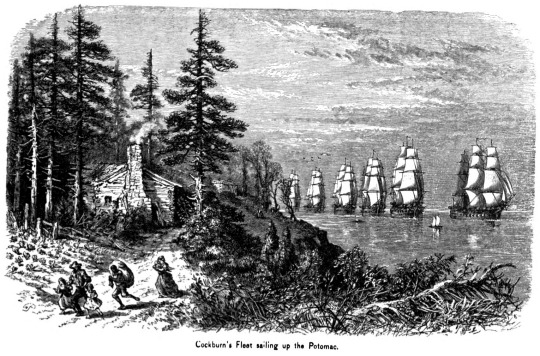
'Cockburn's Fleet sailing up the Potomac,' depicting the 1814 Chesapeake campaign of Sir George Cockburn, an illustration from The History of Our Country by Abby Sage Richardson, 1875 (Google Books).
Although this 19th century book is from a pro-United States position—like most early histories of the War of 1812—my first thought was that the family group that appears to be fleeing might be enslaved Black people seeking refuge with Admiral Cockburn. But this is actually a white family fleeing the British—and with good reason.
The admiral, his Scottish complexion reddened by the relentless Chesapeake sun, was in a good mood, having just completed a series of successful raids that had terrified residents along the Potomac shores of Virginia’s Northern Neck. At 2 a.m. on August 3, Cockburn had headed up the Yeocomico River, probing the inlet off the Potomac with a force of 500 sailors and Royal Marines in twenty barges. Among them, dressed in red coats, were a special company of 120 Colonial Marines—slaves who had escaped to the British from plantations in Virginia and Maryland, and trained to fight their former masters. Their use was a particularly brilliant and insidious stroke, unleashing deep-seated fears among the locals of a slave revolt.
[...] Major Pemberton Claughton, a Virginia militia commander, was shocked to see a slave who had escaped from his plantation among the invaders.
— Steve Vogel, Through the Perilous Fight: Six Weeks That Saved the Nation
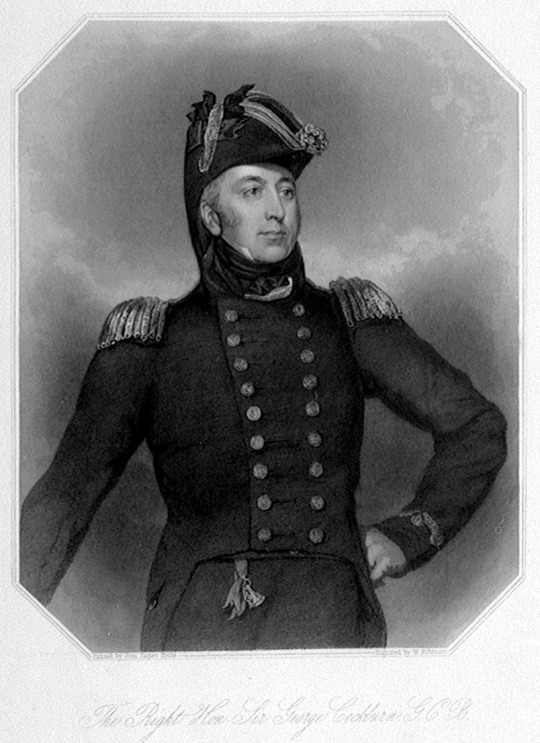
Sir George Cockburn, as he appeared during the War of 1812 (NMM). As much as Cockburn clearly enjoying antagonizing the Americans ("After making a flourish or two there, sacking Leonards Town [on the Potomac’s Maryland shore] … I shall again move elsewhere, so as to distract Jonathan, do him all the mischief I can," he remarked on his strategy), it's hard to portray him as the villian in this situation.
It wasn't actually "Canadians" who torched the White House of enslaver James Madison in Cockburn's attack on Washington, it was his British regulars aided by Royal Navy sailors and Colonial Marines: "the escaped slaves would have the honor of entering the capital as conquerors."
#War of 1812 Wednesday#war of 1812#age of sail#sir george cockburn#royal navy#black history#colonial marines#military history#slavery mention#dressed to kill
15 notes
·
View notes
Text
John Laurens’s great service
How he influenced french policy toward the united colnies.
Without the least intention of detracting from Dr. Benjamin Franklin's undying merit of having perfected the alliance between the American Colonies and France, which league chiefly contributed to the happy consummation of the American War of Independence, still it cannot be denied that the energetic assistance which France had at first accorded to the Colonies had In 1780 grown somewhat lukewarm, on which account Gen. Washington asked Congress to dispatch an envoy extraordinary to France with a view to animate that power to redoubled exertions in furnishing fleets, troops, money, and war material, wherewith to come to the substantial and effective aid of her struggling allies. Congress readily acceded to Washington's request, who selected as envoy Lieut. Col. John Laurens, a young man twenty-seven years of age, but well skilled in diplomatic affairs, perfect master of the French tongue, acquired in France, and, withal, a true American patriot. He undertook the mission in 1781, having as his secretary Major Jackson of Philadelphia.
American historians have mentioned the fact of the mission of John Laurens, a native of South Carolina and son of the illustrious Henry Laurens, who served in country first in 1775 as President of the Committee of Safety, next in 1777, as President of Congress, and last, in 1782, as Commissioner for the treaty of Paris, after a fifteen months’ imprisonment in the Tower of London, answering the British attempts to seduce him from his allegiance to his country with the reply: ”I will never subscribe to my infamy or to the dishonor of my children,” and meeting their threats of confiscating his American possessions with the response: “None of these things can move me.”
But the American historians fall in every instance to give a detailed account of the means by which John Laurens succeeded in accomplishing his mission most thoroughly and effectively, and which are truthfully stated in Major Jackson’s report. The latter relates in plain but convincing terms how John Laurens, upon his arrival on French soil, first had an interview alone with Count de Vergeunes, the Minister of War, from whose whole manner he instantly concluded the intention of the French Cabinet of withholding effective aid from the Colonies, so as to render them more subservient to French interests by a protraction of the war, which would exhaust their means and resources. When a second interview held in the presence of Dr. Franklin, to whom the French Minister, in answer to the urgent requests of John Laurens, referred by the words: “Mais, voilà, Monsieur Franklin; il est très content de nous,” convinced the American Envoy Extraordinary of the fruitlessness of his negotiations with the French diplomat, he resolved, as his last expedient, upon a step of unprecedented boldness, and having penned an eloquent memorial, setting forth the advantages for France of an immediate vigorous assistance of her allies, the American Colonies, he appeared one day at King Louis XIV’s levee, to whom, contrary to all court etiquette, he handed in person his manuscript of the Ministers who were in attendance.
The result was that the very next day John Laurens received from the Minister President Necker an invitation to call on him at a stated time, and was informed then that the King readily acceded to all the demand of the American Congress, and that the Minister of the Marine was commissioned with the instant execution of all stipulations, which would be mutually agreed upon the next day.
These were the instant sailing to America of a strong French fleet under the command of Admiral La Grasse and the immediate dispatch of an order to Count de Rochambeau, then with a French army in Rhode Island, to unite with Gen. Washington, as well ad the liberal supply on the part of France of money and war material to the American Colonies, and they resulted the surrender of Cornwallis at Yorktown.
“Thus,” concludes Major Jackson, the secretary of John Laurens, in his memorable report, “was this important negotiation, which was certainly the hinge on which the success of Revolution then turned, brought to a happy close by the wisdom and decision of a young man who had not then attained his twenty-eighth year, but whose matured mind and heroic spirit admitted no other rule of official conduct than the honor and interest of his beloved country.”
John Laurens fell in an unimportant skirmish with a British marauding party at the Combahee, Aug. 26, 1782, and his body was deposited in the earth near the place where he died, on the plantation of Mrs. Stock, within a simple inclosure, which, as Johnson says in his biography of Gen. Greene, “seems to excite, not answer the inquiry; ‘What undistinguished stranger lies buried here?’.”
DR. F. Muench.
Charleston, S. C., Sept. 15, 1897
3 notes
·
View notes